Italian silent film actor and director Gustavo Serena (1882-1970) is now best remembered as diva Francesca Bertini's co-star, but he did much more than that.
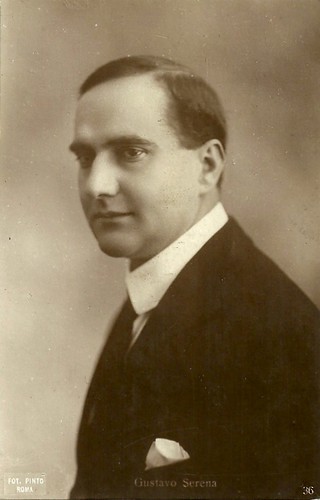
Italian postcard by Ed. A. Traldi, Milano, no. 36. Photo: Pinto, Roma.

Italian postcard by the magazine Film (Naples/Rome). Photo: Caesar Film.
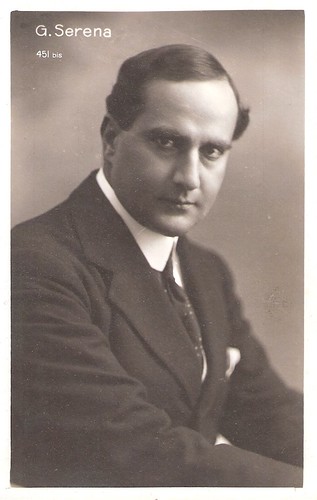
Italian postcard by Vettori, Bologna, no. 451bis.
Gustavo Serena was born into a wealthy Neapolitan aristocratic family in 1881 or 1882. He left his military career for the stage.
In 1909, he switched to the cinema. He made his film debut in the Cines production Bianca Cappello/White Chapel (1909), a period piece by Mario Caserini.
From 1910 on, Serena acted in the films by the Italian Pathé film unit Film d'Arte Italiana. Here he was already paired with his future partner Francesca Bertini in 6 period pieces such as La Contessa di Challant e Don Pedro de Cordova/The Countess de Challant (Gerolamo Lo Savio, 1911), Romeo e Giulietta/Romeo and Juliet (Ugo Falena, 1912) and Lucrezia Borgia (Gerolamo Lo Savio, 1912) with Bertini in the title role of Lucrezia Borgia.
Then, Serena and Bertini both moved to the Cines company, though they did not play together there. At Cines, Serena also started to direct films.
In 1913, he had a major breakthrough as Petronius in the epic Cines film Quo vadis? (Enrico Guazzoni, 1913). The film became a worldwide success and was arguably the first blockbuster in the history of cinema, with 5,000 extras, lavish sets, and a running time of two hours, setting the standard for 'superspectacles' for decades to come.
In 1913 Serena also acted in productions by Roma Film. In 1914, he moved on to the Turinese company Pasquali, where he played in films by Umberto Paradisi and opposite actors as Maria Jacobini and Anna Petersen. In 1915, he left Pasquali and returned to Rome to work at Caesar Film, where he became not only an important actor but also a major director.
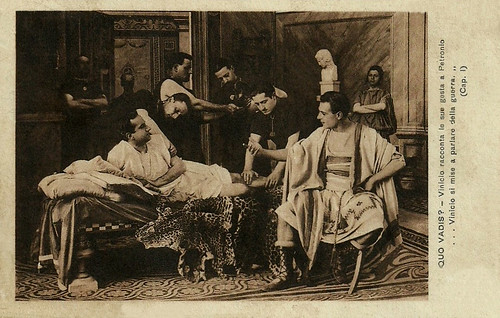
Italian postcard by Film Cines, Roma, no. 6572. Gustavo Serena as Petronius Arbiter and Amleto Novelli as Marcus Vinicius in Enrico Guazzoni's epic film Quo vadis? (produced 1912, released 1913), based on the famous homonymous novel by Henryk Sienkiewicz.
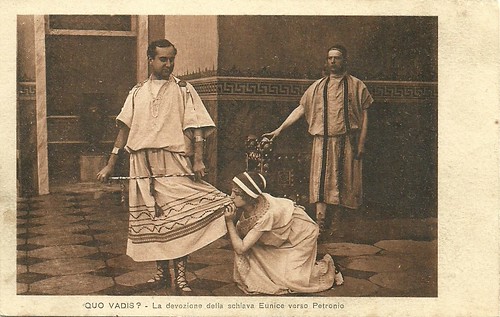
Italian postcard for the classic epic Quo vadis? (Enrico Guazzoni, 1913). Caption: The devotion of the slave Eunice (Amelia Cattaneo) to Petronius (Gustavo Serena).
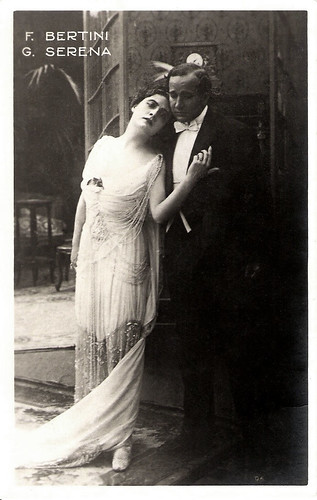
Italian postcard by Vettori. Photo: still from La signora dalle camelie/The Lady of the Camellias (Gustavo Serena, 1915), with Francesca Bertini. The film was based on Alexandre Dumas fils' classic stage play La dame aux camélias, which in its turn was the basis for Giuseppe Verdi's classic opera La traviata.
At Caesar, Gustavo Serena directed various films with Francesca Bertini. In the meantime, she had become an adored film star, a 'diva'.
The first of the films of Serena with Bertini was a classic precursor of neorealism, Assunta Spina (Gustavo Serena, 1915), based on a Neapolitan stage play by Salvatore Di Giacomo.
Wikipedia: "One of the aims of creating this film was to reveal the subtle expressive power of filmmaking, compared to theatrical plays. Francesca Bertini' fully displayed her talent for the first time, setting a new standard for acting on the silver screen. Her performance is generally rated as extraordinary, and in polar opposition to the work of writer and dramatist Gabriele D'Annunzio who was very popular at the time."
Today, Serena's direction of the film is discussed; some historians maintain that Bertini directed a part of or even the whole film.
At Caesar, Serena played the lead opposite Bertini in 11 feature films. Of these, he both directed and played in Assunta Spina (1915), Diana l'affascinatrice/Diana, the Adventuress (1915), Ivonne la bella danzatrice/Yvonne, the Beautiful Dancer (1915), Il capestro degli Asburgo/The Rope of Habsburg (1915), and La signora dalle camelie/The Lady of the Camelias (1915).
In 1916, Giuseppe De Liguoro took over the direction of the Bertini-Serena films, including Odette (1916) and Fedora (1916). The following year, Serena again both directed and acted in Andreina (1917). After that, Alfredo De Antoni took over and he directed the golden couple Bertini-Serena in such successes as Il processo Clémenceau/The Clemenceau Affair (1917), Tosca (1918) and Frou-Frou (1918).
When Bertini starred in seven films based on the 7 mortal sins, Serena played opposite her in L'ira/Anger (Edoardo Bencivenga, 1918) and L'avarizia/Greed (Gustavo Serena, 1919). These were their last collaborations. Then Gustavo Serena was replaced as Francesca Bertini's co-star by actors such as Livio Pavanelli, Sandro Salvini and Mario Parpagnoli.
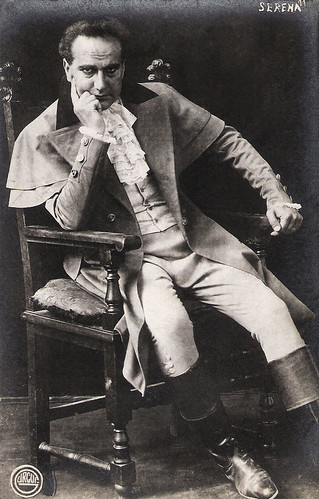
Spanish postcard by Gurgui, no. 11. Gustavo Serena in Tosca (1918).
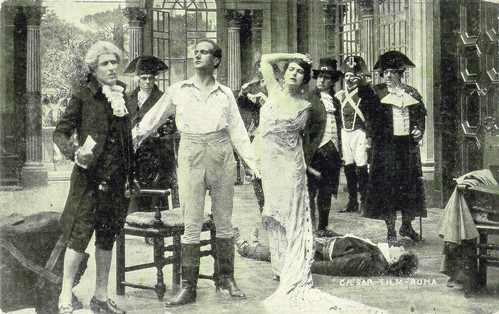
Spanish postcard by Amattler Marca Luna, series 5, no. 10. Photo: Caesar Film. Publicity still for Tosca (Alfredo De Antoni, 1918), starring Francesca Bertini as Floria Tosca and Gustavo Serena as Mario Cavaradossi. After having killed Angelotti, Sacrpia (Alfredo De Antoni) arrests Caravadossi, to Tosca's despair.
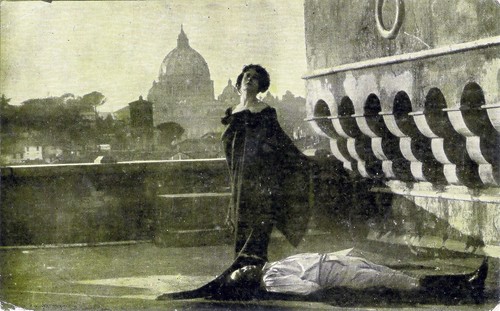
Spanish postcard by Amattler Marca Luna, series 5, no. 18. Photo: Caesar Film. Publicity still for Tosca (Alfredo De Antoni, 1918), starring Francesca Bertini as Floria Tosca and Gustavo Serena as Mario Cavaradossi. The execution of Cavaradossi on the roof of the Castel Sant' Angelo, with St Peter's cupola in the distance. Tosca discovers Scarpia's (Alfredo De Antoni) betrayal. She herself has just stabbed Scarpia to death. When Scarpia's men try to arrest her, she jumps of the roof with the words: "O Scarpia, davanti a Dio!"
While not making films with Bertini anymore, Gustavo Serena continued to direct films at Caesar, with actors from its regular troupe, such as Carlo and Olga Benetti.
Among these films were A San Francisco (1915), based on another play by Di Giacomo; Parigi misteriosa/Mysterious Paris (1917), based on Eugene Sue's novel Les mystères de Paris, and Fernanda (1917), starring Leda Gys. He often played in these films too. Serena continued to direct films up to 1923, often with the actresses Anna Fougez, Tilde Kassay and Nella Serravezza.
Until 1926, Serena regularly acted in films too, including the German 2-part period piece Sterbende Völker/Dying People (Robert Reinert, 1922), shot in Italy; the fascist propaganda piece Il grido dell'aquila/The Shout of the Eagle (Mario Volpe, 1923); the Ronald Colman-Lilian Gish melodrama The White Sister (Henry King, 1923), an American production shot in Italy, and Fra Diavolo (Roberto Roberti, Mario Gargiulo, 1925) in which Serena played the title role.
When sound film came to Italy, Serena made a handful films, based on regional theater, such as Zappatore (1930), in which he played the lead himself. He quitted directing after that, but continued to play minor roles in Italian sound films in the late 1930s.
During the war years, Serena was production manager for a few films. Again from the late 1940s and all through the 1950s, he acted in several films, though in small parts. His last roles were even uncredited: bit parts in I soliti ignoti/Big Deal on Madonna Street (Mario Monicelli, 1959) and Don Camillo monsignore ma non troppo/Don Camillo: Monsignor (Carmine Gallone, 1961).
Gustavo Serena's parabole ended in 1970, when he died in Rome. He was 88. Serena had appeared in 107 films and had directed 33 films.
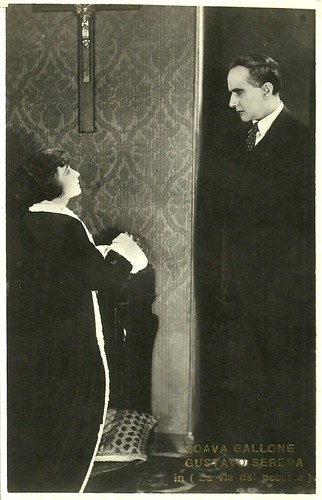
Italian postcard. Photo: Soava Gallone and Gustavo Serena in La via del peccato/The Way of Sin (Amleto Palermi, 1925).
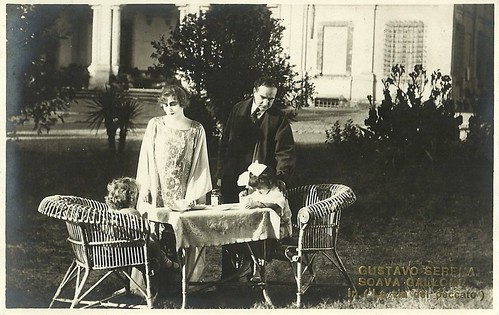
Italian postcard. Photo: Soava Gallone and Gustavo Serena in La via del peccato/The Way of Sin (Amleto Palermi, 1925).
Sources: Aldo Bernardini/Jean A. Gili (Le cinéma italien 1905-1945), Gianfranco Mingozzi/Vittorio Martinelli (Francesca Bertini), Wikipedia and IMDb.

Italian postcard by Ed. A. Traldi, Milano, no. 36. Photo: Pinto, Roma.

Italian postcard by the magazine Film (Naples/Rome). Photo: Caesar Film.

Italian postcard by Vettori, Bologna, no. 451bis.
Francesca Bertini
Gustavo Serena was born into a wealthy Neapolitan aristocratic family in 1881 or 1882. He left his military career for the stage.
In 1909, he switched to the cinema. He made his film debut in the Cines production Bianca Cappello/White Chapel (1909), a period piece by Mario Caserini.
From 1910 on, Serena acted in the films by the Italian Pathé film unit Film d'Arte Italiana. Here he was already paired with his future partner Francesca Bertini in 6 period pieces such as La Contessa di Challant e Don Pedro de Cordova/The Countess de Challant (Gerolamo Lo Savio, 1911), Romeo e Giulietta/Romeo and Juliet (Ugo Falena, 1912) and Lucrezia Borgia (Gerolamo Lo Savio, 1912) with Bertini in the title role of Lucrezia Borgia.
Then, Serena and Bertini both moved to the Cines company, though they did not play together there. At Cines, Serena also started to direct films.
In 1913, he had a major breakthrough as Petronius in the epic Cines film Quo vadis? (Enrico Guazzoni, 1913). The film became a worldwide success and was arguably the first blockbuster in the history of cinema, with 5,000 extras, lavish sets, and a running time of two hours, setting the standard for 'superspectacles' for decades to come.
In 1913 Serena also acted in productions by Roma Film. In 1914, he moved on to the Turinese company Pasquali, where he played in films by Umberto Paradisi and opposite actors as Maria Jacobini and Anna Petersen. In 1915, he left Pasquali and returned to Rome to work at Caesar Film, where he became not only an important actor but also a major director.

Italian postcard by Film Cines, Roma, no. 6572. Gustavo Serena as Petronius Arbiter and Amleto Novelli as Marcus Vinicius in Enrico Guazzoni's epic film Quo vadis? (produced 1912, released 1913), based on the famous homonymous novel by Henryk Sienkiewicz.

Italian postcard for the classic epic Quo vadis? (Enrico Guazzoni, 1913). Caption: The devotion of the slave Eunice (Amelia Cattaneo) to Petronius (Gustavo Serena).

Italian postcard by Vettori. Photo: still from La signora dalle camelie/The Lady of the Camellias (Gustavo Serena, 1915), with Francesca Bertini. The film was based on Alexandre Dumas fils' classic stage play La dame aux camélias, which in its turn was the basis for Giuseppe Verdi's classic opera La traviata.
Golden Couple
At Caesar, Gustavo Serena directed various films with Francesca Bertini. In the meantime, she had become an adored film star, a 'diva'.
The first of the films of Serena with Bertini was a classic precursor of neorealism, Assunta Spina (Gustavo Serena, 1915), based on a Neapolitan stage play by Salvatore Di Giacomo.
Wikipedia: "One of the aims of creating this film was to reveal the subtle expressive power of filmmaking, compared to theatrical plays. Francesca Bertini' fully displayed her talent for the first time, setting a new standard for acting on the silver screen. Her performance is generally rated as extraordinary, and in polar opposition to the work of writer and dramatist Gabriele D'Annunzio who was very popular at the time."
Today, Serena's direction of the film is discussed; some historians maintain that Bertini directed a part of or even the whole film.
At Caesar, Serena played the lead opposite Bertini in 11 feature films. Of these, he both directed and played in Assunta Spina (1915), Diana l'affascinatrice/Diana, the Adventuress (1915), Ivonne la bella danzatrice/Yvonne, the Beautiful Dancer (1915), Il capestro degli Asburgo/The Rope of Habsburg (1915), and La signora dalle camelie/The Lady of the Camelias (1915).
In 1916, Giuseppe De Liguoro took over the direction of the Bertini-Serena films, including Odette (1916) and Fedora (1916). The following year, Serena again both directed and acted in Andreina (1917). After that, Alfredo De Antoni took over and he directed the golden couple Bertini-Serena in such successes as Il processo Clémenceau/The Clemenceau Affair (1917), Tosca (1918) and Frou-Frou (1918).
When Bertini starred in seven films based on the 7 mortal sins, Serena played opposite her in L'ira/Anger (Edoardo Bencivenga, 1918) and L'avarizia/Greed (Gustavo Serena, 1919). These were their last collaborations. Then Gustavo Serena was replaced as Francesca Bertini's co-star by actors such as Livio Pavanelli, Sandro Salvini and Mario Parpagnoli.

Spanish postcard by Gurgui, no. 11. Gustavo Serena in Tosca (1918).

Spanish postcard by Amattler Marca Luna, series 5, no. 10. Photo: Caesar Film. Publicity still for Tosca (Alfredo De Antoni, 1918), starring Francesca Bertini as Floria Tosca and Gustavo Serena as Mario Cavaradossi. After having killed Angelotti, Sacrpia (Alfredo De Antoni) arrests Caravadossi, to Tosca's despair.

Spanish postcard by Amattler Marca Luna, series 5, no. 18. Photo: Caesar Film. Publicity still for Tosca (Alfredo De Antoni, 1918), starring Francesca Bertini as Floria Tosca and Gustavo Serena as Mario Cavaradossi. The execution of Cavaradossi on the roof of the Castel Sant' Angelo, with St Peter's cupola in the distance. Tosca discovers Scarpia's (Alfredo De Antoni) betrayal. She herself has just stabbed Scarpia to death. When Scarpia's men try to arrest her, she jumps of the roof with the words: "O Scarpia, davanti a Dio!"
Fascist Propaganda Piece
While not making films with Bertini anymore, Gustavo Serena continued to direct films at Caesar, with actors from its regular troupe, such as Carlo and Olga Benetti.
Among these films were A San Francisco (1915), based on another play by Di Giacomo; Parigi misteriosa/Mysterious Paris (1917), based on Eugene Sue's novel Les mystères de Paris, and Fernanda (1917), starring Leda Gys. He often played in these films too. Serena continued to direct films up to 1923, often with the actresses Anna Fougez, Tilde Kassay and Nella Serravezza.
Until 1926, Serena regularly acted in films too, including the German 2-part period piece Sterbende Völker/Dying People (Robert Reinert, 1922), shot in Italy; the fascist propaganda piece Il grido dell'aquila/The Shout of the Eagle (Mario Volpe, 1923); the Ronald Colman-Lilian Gish melodrama The White Sister (Henry King, 1923), an American production shot in Italy, and Fra Diavolo (Roberto Roberti, Mario Gargiulo, 1925) in which Serena played the title role.
When sound film came to Italy, Serena made a handful films, based on regional theater, such as Zappatore (1930), in which he played the lead himself. He quitted directing after that, but continued to play minor roles in Italian sound films in the late 1930s.
During the war years, Serena was production manager for a few films. Again from the late 1940s and all through the 1950s, he acted in several films, though in small parts. His last roles were even uncredited: bit parts in I soliti ignoti/Big Deal on Madonna Street (Mario Monicelli, 1959) and Don Camillo monsignore ma non troppo/Don Camillo: Monsignor (Carmine Gallone, 1961).
Gustavo Serena's parabole ended in 1970, when he died in Rome. He was 88. Serena had appeared in 107 films and had directed 33 films.

Italian postcard. Photo: Soava Gallone and Gustavo Serena in La via del peccato/The Way of Sin (Amleto Palermi, 1925).

Italian postcard. Photo: Soava Gallone and Gustavo Serena in La via del peccato/The Way of Sin (Amleto Palermi, 1925).
Sources: Aldo Bernardini/Jean A. Gili (Le cinéma italien 1905-1945), Gianfranco Mingozzi/Vittorio Martinelli (Francesca Bertini), Wikipedia and IMDb.
No comments:
Post a Comment